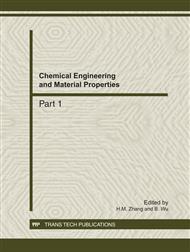p.1017
p.1022
p.1027
p.1031
p.1036
p.1041
p.1047
p.1051
p.1055
Preparation and Characterization of Lanthanum (La)-Doped TiO2
Abstract:
Lanthanum-doped anatase TiO2 coatings, which were composed of assemble crystalline of 50 nm diameter particles have been successfully fabricated by sol–gel dip-coating process on light leakage quartz fiber (LQF) which length is 15cm and diameter is 125μm. This was achieved by adjustment of the lanthanum-doped sol–gel parameters such as molar ratio of precursors in lanthanum-doped TiO2-sols, the ratio of titanium tetrabutoxide to polyvinyl alcohol, dip-coating velocity, drying duration in air, thermal treatment and number of cyclical time of the process. Titania nano crystals were prepared by ambient temperature in a liquid media using titanium tetrabutoxide as precursor, and the crystallization of amorphous precursor was preceded by peptizing with acid and then refluxing for a periodic time in homothermal water-bath. The photocatalytic properties of the lanthanum-doped TiO2 films were testified by the photo degradation of methyl orange. The lanthanum-doped anatase TiO2 thin films were characterized by XRD and TEM.
Info:
Periodical:
Pages:
1036-1040
Citation:
Online since:
December 2011
Authors:
Keywords:
Price:
Сopyright:
© 2012 Trans Tech Publications Ltd. All Rights Reserved
Share:
Citation:


